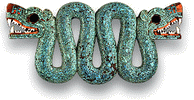Stele with Conquest Scene found at Lagartero, Chiapas
Category: News reportsJanuary 15, 2010. INAH. At Lagartero, Chiapas, archaeologists from the National Institute of Anthropology and History (INAH) discovered a nearly 1000 years-old stele with a bas-relief of the conquest of a Maya group by other.
The finding took place in late 2009 at the 10th body of Pyramid 4 in the archaeological zone to be open to public visit in 2010, according to the list of sites being inaugurated during the administration of President Felipe Calderon.
Archaeologist Sonia Rivero Torres, in charge of Lagartero Archaeological Project, informed that the stele – the first one found complete in the site- is approximately 200 centimeters long, 55 wide and 6 thick. It was carved on a metamorphic rock known locally as “Heart of stone”.
“We can observe the profile of a Maya ruler standing with a bag of copal on one hand, dressed with a loincloth, sandals and a feather headdress. At his feet, lying on his back, there is another character with his chest open, symbolizing sacrifice or domain”.
“The scene presents death elements, such as the long-bone frieze. By its location and style, we deduct the stele refers to a Maya seignior who came from a near region and conquered the city known today as Lagartero around 1000 AD”, pointed out the archaeologist.
The stele was found inside a rectangular cist, looted probably since Prehispanic times, since no osseous rests were found, according to the Archaeological Studies Direction (INAH-DEA) expert.
Last field season that included exploration and consolidation of Pyramid 4, represented more findings. In a lower level of the structure, 2 big flat bowls (complete but in fragments), one of them with an entire pot inside, were found.
A Codex-style polychrome dish and a black vase with a zoomorphic cover with a jadeite offering inside, including necklace beads, 2 ear ornaments and an articulated tortoise were also found. The second cist was used in 800 AD, at the Late Classic period.
A third cist was found in the fifth body of Pyramid 4, with 40 black-slip vessels, zoomorphic pots and some human bones.
Place of Alligators
Lagartero Ceremonial Center extends over the 8 hectares (acquired by INAH) of El Limonar islet, the greatest of 11 distributed in the lake zone known as Lagos de Colon, in Chiapas.
Archaeologist Rivero pointed out that according to ceramic elements found during 12 research seasons carried out since 1990 at Lagartero, it was occupied from Classic to Early Post Classic periods (300 to 1200 AD).
Its strategic position in the marshes gave it control over these natural resources, having the possibility of restricting access. Lagartero was a key point for goods and produce exchange between Guatemala highlands and the Central High Plateau.
To present, a ballgame court and its 5 altars have been consolidated, as well as East and Southwest structures. Seven dwelling buildings have been liberated.
At the main square, 3 out of 4 pyramids are already consolidated; work during 2010 will concentrate in Number 2, the greatest, with an 11 meters height.
Source – INAH.


